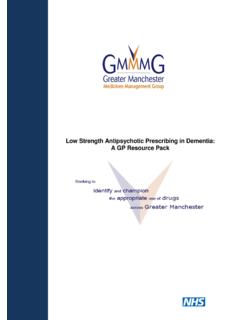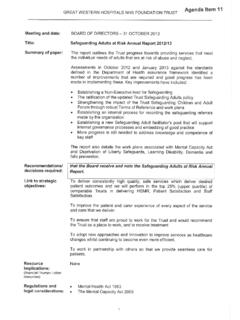Transcription of Barriers to implementing ‘restraint free care’ policies ...
1 Barriers to implementing restraint free care policies (April 2005)Research Summary and Resource MaterialFunded by The Bernard Judd FoundationThe National Ageing Research Institute (NARI) undertook a study examining restraint use(physical, chemical and environmental) in residential aged care settings. Reducing falls and injury,managing aggression, understaffing and reducing legal liabilities have been reported in theliterature as some of the reasons for restraint use. However, research evidence indicates thatdespite the reasons for using restraint, there is little evidence available to support and physical harms have been reported to be associated with various forms ofrestraint.
2 The last decade has seen a shift towards restraint reduction policies and better qualitycare with the introduction of AimThe aim of this research was to: Identify Barriers to implementing restraintfree care policies in the residential qualitative methodology was used to explorethe use of restraints in three residential agedcare facilities in metropolitan Melbourne. Thismethodology allowed exploration of policies ,processes, beliefs and attitudes that influencedthe use of restraints in these facilities, allhaving different levels of restraint use. Themethodology aimed to develop a detaileddescription of restraint use in each facility bydrawing on views of residents, family members,managers, direct care staff, medical staff aswell as documenting each facility s restraintpolicy.
3 Data collection methods includedinterviews, focus groups and policy following strategies have been developedas a result of this study. They assist inaddressing Barriers that have been identified inimplementing restraint free care policies . Thisis not a comprehensive list of support and information can beobtained from the resources provided on thelast page of this flyer. A full report of this studyis available on the National Ageing ResearchInstitute s website: :Implement a formal restraint policy:The following principles could be used inpolicy implementation - The least possible use of restraint.
4 Involvement of residents, families andinterdisciplinary team in the decisionmaking process. Physical restraint assessment undertakenand documentation of approved devices. Specification of a review period. Checking of devices before and during usefor safety and appropriateness. Full documentation of the purpose ofrestraint. Chemical restraint only as a last , C. (2003). Restraint. Dementia Nursing. AGuide to Practice. R. Hudson. Melbourne, restraint policy could also include - An agreed definition of physical andchemical restraints . Management support for restraint-freecare or restraint minimisation.
5 Open communication between all staff,doctors, family members and residents. Purchase of equipment to support removalof restraints , high-low beds. Monitoring level of restraint use and fallsrates over time to assess the impact andeffectiveness of the policy. Communication program, promoting for Daily Practice:Assessment, Monitoring and Review:Undertake holistic assessment, monitoring andreview - When assessing or reviewing whether arestraint is required, undertake a caseconference involving family, doctors,PCAs, nurses and allied health staff. A behaviour chart may be useful foridentifying triggers and time of day ofbehaviour that could put the resident orother residents at risk.
6 Regular review of restraint authorisationcould include:- For medications a chart should be usedidentifying the desired outcome andtarget behaviour of the medication. Thischart should identify when a reviewshould be undertaken to determinewhether the desired outcome has beenachieved and whether the medicationneeds to be altered or ceased;- Flagging when restraint authorisationsare due for review. Having thisinformation in individual resident s notesdoes not appear to be an effectiveflagging mechanism;- Reviews need to be viewed as anopportunity for removing restraint ratherthan a legal requirement for continuingthe use of restraint.
7 Regular monitoring of restraints :- Residents who are physically restrainedneed to have restraints releasedfrequently and to have regularmovement and Centred care :Strategies identified for client centred careinclude: Placing at risk residents near the nurses station or in a position that is easy for staffto observe. Spending one-on-one time with residents. Meeting the cultural needs of to employ staff who can speak thesame language as residents. Useinterpreters for translating needs. Find outfrom family members the preferences ofthe resident who doesn t speak English. Develop strategies for enhancingcommunication and adequate handoverbetween permanent and agency Centred care (continued): Good communication and interaction andbeing where the resident is at the time.
8 Staff to imagine themselves in a restraintor being faced with the dilemma of familymembers trying to decide whether or notto authorise restraints on their of the residential care environmentas the resident s home, where they haverights and freedom and deserve to betreated with respect and dignity. Try innovative approaches to addressindividual s needs, such as music,aromatherapy, adjusting lighting, goingoutdoors. Some strategies may work oneday but not the next. Finding the right levelof stimulation (not over or under-stimulate,for example noise) - may require a trialand error approach.
9 Refer also to assessment, monitoring andreview (above).Activities and Diversion:Provide flexible and innovative programs: Provide programs for residentsexperiencing sundowners. Employ activities staff in the evening,particularly between 4-7pm. Provide normal experiences for residentssuch as taking them on outings, out intothe sunshine. Giving a resident a cup of tea or asandwich has been described as providinga diversion and calming residents down. Provide a range of activities. Examples ofprograms include: tai chi, craft, bingo,cards, cooking, men s club, ethnic club,movies, outings ( shopping, pokies).
10 If a resident is getting agitated, trychanging their scenery, taking them for awalk, taking them to another place in thefacility or outside. Do not assume that non-responsiveresidents are not capable of respondingbut that the activities provided may not beeffectively engaging them. Find out whattheir interests were at other times in theirlife. Use volunteers for increasing socialinteraction for of Devices to Prevent Falls and FallsRelated Injuries:The following devices were identified forpreventing falls and falls related injuries: High-low beds so that residents don t haveso far to fall out of bed.










